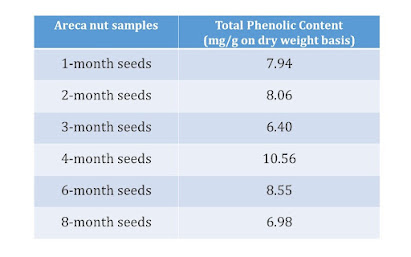In the last
couple of Blogs, the arecoline & other alkaloid contents in the green
immature areca nut studied in different countries was discussed. In this Blog, arecoline
& other alkaloid content of the areca fruits of 9-10 month’s maturity is discussed.
Shivashankar
et al., (1968) from CFTRI Mysore, had studied the chemical composition of Chali (White supari) purchased from important areca growing regions of Kerala and Karnataka over two
years (1964 to 1966). They had used rudimentary methods available at that time
to estimate arecoline content. They concluded that the arecoline content varies
between 0.1 to 0.7 % in Chali on dry weight basis, collected from different
areca growing regions of Karnataka and Kerala state of India.
Wang et al.,
(1997), had studied the arecoline content of areca nuts of 9-10 months’
maturity collected from Taiwan. They had reported the arecoline content of
0.16% in the ripened fruit on fresh weight basis. Jantarat et
al., (2013) had reported an arecoline content of 0.094 % in 8 months old, matured nuts on fresh weight basis. They had collected the areca nut sample
from Nakhon Si Thammarat, Thailand.
Chavan and
Singhal (2013) had analyzed the arecoline content of Chali purchased from the
local market in Mumbai using HPLC method. They had reported an arecoline
content of 1.279% (12.79 mg/g). Jain et
al., (2017), have done a comprehensive study of arecoline content in Chali and
various areca nut products sold in the market in China and India. They had
reported an arecoline content of 0.064 to 0.222 % (dry weight) using advance
LC-MS/MS method. Arecoline content of 0.119% was the median value and 0.127%
was the mean value in the Chali (white supari) collected from the bulk traded
in the Mumbai market. The arecoline content found in the Gutka samples produced
and sold in India were 0.074 & 0.116 %. The arecoline content in the Bing
lang purchased from Hunan province China were in the range of 0.107 to 0.144%. Levels of Guvacine ranged from 0.139 to 0.816%
dry weight, accounting for more than 50% of the total alkaloid content in most
of the products. The levels of Arecaidine and Guvacoline ranged from 0.014 % to
0.170 % and 0.017 % to 0.099 % dry weight, respectively.
In conclusion,
about a dozen alkaloids have been identified so far in areca nuts and Arecoline
is considered as a key biologically active alkaloid among them. Its
concentration will be high in the early developmental stage and decreases with
maturity. Areca nut cultivated in Taiwan, China, Indonesia and Darwin Island,
Australia, reported arecoline content on higher side (0.3% and above) in the unripe
green nuts. Whereas the unripe green areca nuts studied in Thailand and India
had lower arecoline content (less than 0.3%). Lot of variation (up to 400%) in
arecoline concentration was found in areca nuts cultivated in different
regions. The analysis of various areca
nut samples sold in the market revealed that the arecoline content in them is
in the range of 0.064 to 0.222 % (0.64 to 2.22 mg/g). In one instance, the arecoline
content was found to be as high as 1.279% (12.79 mg/g) in Chali sample
collected from Mumbai market, India.
References:
Shivashankar
et al., (1968). Physical and chemical characteristics of processed areca nuts.
Journal of Food Science & Technology, Vol. 6, pp. 113-116.
Wang et al.,
(1997), Contents of Phenolics and Alkaloids in Areca catechu Linn. During Maturation,
Journal of Agriculture & Food Chemistry. Vol. 45, pp. 1185-1188
Jantarat et
al., (2013), A Simple and Rapid HPLC Technique for Determination of Arecoline
in Areca Nut (Areca catechu L.) Extract, Walailak Journal of Science
& Technology, Vol. 10(1), pp. 57-66.
Chavan &
Singhal (2013). Separation of polyphenols and arecoline from areca nut (Areca
catechu L.) by solvent extraction, its antioxidant activity, and identification
of polyphenols. Journal of Science of Food & Agriculture. Vol. 93(10), pp. 2580–2589.
Jain et al
(2017). Analysis of Alkaloids in Areca Nut-Containing Products by Liquid Chromatography−Tandem
Mass Spectrometry. Journal of Agricultural and Food Chemistry, Vol. 65, pp. 1977−1983













